UMS – Urkesh/Mozan Studies
|
This first section is dedicated to the major series related to Tell Mozan, entitled Urkesh/Mozan Studies; it continues directly the earlier series which was simply entitled Mozan and which has been discontinued (hence there are no volumes 1 and 2 in the UMS series). The series Urkesh/Mozan Studies evolves directly from an earlier series entitled Mozan, of which it continues the numeration. The sequence of volumes is as follows: |
| Mozan 1 |
Giorgio Buccellati and Marilyn Kelly–Buccellati (eds) The Soundings of the First Two Seasons. Bibliotheca Mesopotamica 20. Malibu: Undena Publications, 1988. TABLE OF CONTENTS 1. Introduction (Giorgio Buccellati and Marilyn Kelly–Buccellati) 1.1 Earlier work 1.2 The Mozan Archaeological Project 1.3 Results and perspectives 1.4 Acknowledgments 2. Scope of the Research (Giorgio Buccellati) 2.1 Environmental considerations 2.2 Historical considerations 2.3 Archaeological considerations 2.4 Methodological considerations 3. The High Mound: Introduction and Surface Collection (Marilyn Kelly–Buccellati) 3.1 Introduction 3.2 Distributional patterns 3.3 Conclusions 3.4 Mozan Ware descriptions 3.5 A note on mapping (Steven Hughey) 4. The Outer City: Introduction and Surface Collection (Judith Thompson Miragliuolo) 4.1 Introduction (Giorgio Buccellati and Marilyn Kelly–Buccellati) 4.2 Surface collection 4.3 Relative percentages 4.4 Distributional patterns 5. Soundings on the High Mound 5.1 Introduction (Giorgio Buccellati and Marilyn Kelly–Buccellati) 5.2 The stone building in Area B (Giorgio Buccellati) 5.2.1 Horizontal articulation 5.2.2 Main stratigraphic sequence 5.2.3 Artifact distribution 5.3 Le mur d'enceinte, Area K (Guy Bunnens and Arlette Roobaert) 5.3.1 Les restes visibles 5.3.2 Les sondages 6. Artifacts from the Excavations (Marilyn Kelly–Buccellati) 6.1 The ceramics 6.2 The seal impressions 6.2.1 Introduction 6.2.2 Technique 6.2.3 The Catalog 6.2.3.4 Conclusions 6.2.3.1 Door sealings from K1 6.2.3.2 Door sealings from K2 6.2.3.3 Other sealed objects 6.3 Other objects 7. Samples from the Excavations 7.1 Paleobotanical samples from the City Wall (Kathleen Galvin) 7.1.1 Sample One – K1.2 7.1.2 Sample Two – K1.14 7.1.3 Cultural Inferences 7.2 14C determinations (Linda Mount–Williams) 8. Regional Survey 8.1 Introduction (Giorgio Buccellati and Marilyn Kelly–Buccellati) 8.2 Tell Shermola (Amouda): Reconnaissance préliminaire (Guy Bunnens and Arlette Roobaert) 8.2.1 Étendue du site antique 8.2.2 Le tertre 8.2.3 Céramique et datation 9. Appendices 9.1 Comments on the Urkish Lion Pegs (Oscar Muscarella) 9.1.1 Metal analysis (Peter Meyers) 9.2.1 Introduction (Giorgio Buccellati) 9.2 Computer applications 9.2.2 CAD Reconstructions of the building in Area B (Andrea Parker) |
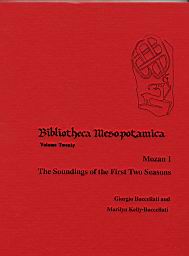
|
| Mozan 2 |
Lucio Milano, with Mario Liverani, Giorgio Buccellati and Marilyn Kelly–Buccellati (eds) The Epigraphic Finds of the Sixth Season. Syro–Mesopotamian Studies 5/1. Malibu: Undena Publications, 1991. TABLE OF CONTENTS 1. Introduction. G. Buccellati and M. Kelly–Buccellati 1.1 The sixth season of excavations at Tell Mozan 1.2 Archaeological objectives 1.3 The epigraphic finds 1.4 Notes on third millennium ceramic chronology at Mozan 1.5 An inscribed sherd of the fifth season (M2 3) 2. The archaeological context – M. Liverani 2.1 The general setting 2.2 Stratigraphy of Area F1 2.3 The ceramic horizon 2.4 The findspot of the tablets 3. Philological presentation – L. Milano 3.1 Introduction 3.2 Description of the tablets 3.3 Texts in transliteration 3.4 Palaeography 3.5 Content and structure of the texts 3.6 Notes on the personal names 3.7 Conclusions 4. References |
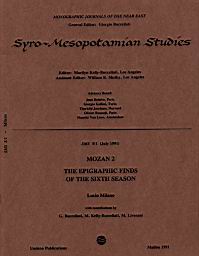
|
| UMS 3 |
Giorgio Buccellati and Marilyn Kelly–Buccellati (eds) Urkesh and the Hurrians. A Volume in Honor of Lloyd Cotsen. Bibliotheca Mesopotamica 26. Malibu: Undena Publications, 1998. Giorgio Buccellati: Preface
|
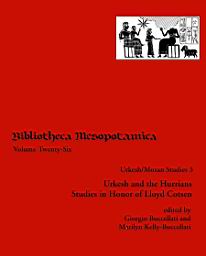
|
| UMS 4 |
Sophie Bonetti (ed.) Gli Opifici di Urkesh. Conservazione e restauro a Tell Mozan. Bibliotheca Mesopotamica 27. Malibu: Undena Publications, 2001. INDICE Cristina Acidini: Presentazione Indice delle materie Lista delle figure Lista delle illustrazioni I. Le istituzioni 1. Giorgio Bonsanti: L'Opificio delle Pietre Dure: ampliamenti geografici e cronologici 2. Maurizio Michelucci: Il restauro archeologico e la Scuola di Alta Formazione per restauratori 3. Sophie Bonetti: Il laboratorio in cantiere 4. Giorgio Buccellati: Il cantiere come laboratorio II. Il sito 5. Giorgio Buccellati: Il contesto storico e stratigrafico 6. Marilyn Kelly–Buccellati: L'arte di Urkesh III. Le attivitá 7. Beatrice Angeli e Sophie Bonetti: Il laboratorio di restauro nella missione di scavo: problemi di intervento sul terreno; i materiali 8. Peter Pfälzner: The Functional Use of Conservation: from Sherds to Jars to Rooms 9. Giorgio Buccellati: Dai mattoni all'architettura 10. Federico Buccellati: Digital Photography and Architectural Modeling as Elements of Conservation 11. Paolo Emilio Pecorella, Lanfredo Castelletti, Giacomo Chiari: Commenti e dibattito Bibliografia sugli scavi |
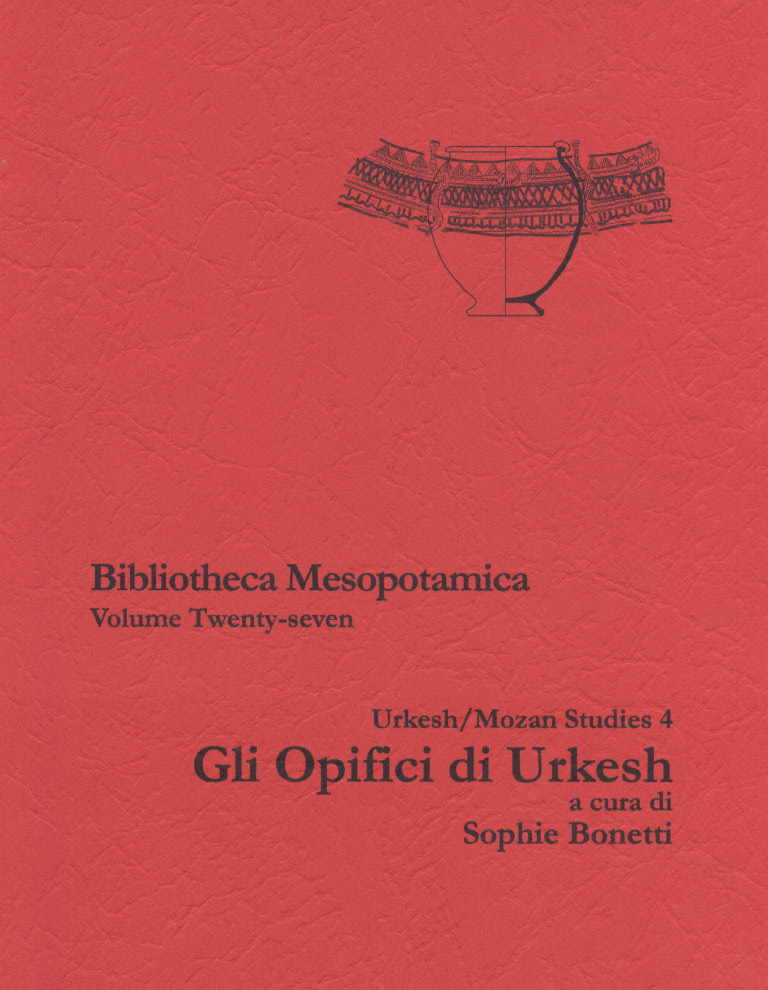
|
| UMS 5 |
Rick Hauser Reading Figurines Animal Representations in Terra Cotta from Royal Building AK. Bibliotheca Mesopotamica 28. Malibu: Undena Publications, 2007. CONTENTS: Acknowledgments Foreword by Giorgio Buccellati A Guide for the Reader INTRODUCTION: Before the Typology Animal Observed Genera The Template is Broken Terminology The Typology Renderings of Roster Entries Genera and Types Views Variables Cranial & Caudal Views of the Animal Figurines – The Urkesh Corpus Similar body types: de Genouillac at Telloh Local Sources of Clay Manufacture: Fabric Manufacture: Color Manufacture: Inclusions Manufacture: Surface Treatment (Incisions, Combing, Folding, and Pinching) New Approaches to Reading Figurines Reading Figurines at Urkesh Realism Counting the Finds A Rendering Legend Domestication and Taming Other Disciplines The Impossible Bargain of the Ishar–Beli COMPARANDA: Representative Sites Comparative Material GENUS Bos: DISCUSSION: The Genus and Catalog, The Urkesh Corpus A miniature Genus Measurements Identification Genus Bos A Rare Example Horns GENUS Bos: CATALOG: The Urkesh Corpus Bos Tentative Identification Related Stratified Finds Related Unstratified Finds Horns Horns – A Tentative Identification GENUS Ovis: DISCUSSION: The Genus and Comparative Material from Other Sites A Domesticated Group The Typology The Figurines Shared Characteristics Other Fragmentary Finds (Body) GENUS Ovis: CATALOG: The Urkesh Corpus Ovis Type I Tentative Identification Related Stratified Finds Related Unstratified Finds Ovis Not Identified by Type – Fragments & Related Objects Related Stratified Finds Related Unstratified Finds GENUS Canis: Comparative Body Types Canis DISCUSSION: The Genus and Comparative Material from Other Sites The Canid Body type Canis at Assur The Spitz Type Attitude and Other Characteristics Domesticated Dogs Canis in Ancient Urkesh GENUS Canis: CATALOG: The Urkesh Corpus Canis Tentative Identification Related Stratified Finds Related Unstratified Find GENUS Felis / Ursus / Mellivora Orders (Suborders) Insectivora / Rodentia (Hystricognathi) Families Erinaceidae / Hystricidae The Urkesh Corpus Felis Type I Comparative Body Types Felis Type I1 Comparative Body Types DISCUSSION: The Genera and Comparative Material from Other Sites A Type Apart Lions at Urkesh Carnivores and Herbivores at Mozan The Typology Felis Type I and Type II Domestication of the Wild Cats Taming Lions Dancing Bears Carnivora: A Beginning Alternative Typology Incomplete Figurines and Fragments CATALOG: The Urkesh Corpus Carnivora fera (Other Nondomesticated Animals) Hystricomorpha (Porcupine) Erinaceidae (Hedgehog) Mustelidae (Honey Badger) Tentative Identification (Ursus) Related Stratified Find GENUS Equus The Genus and Comparative Material from Other Sites Equus Types I, I/II Comparative Body Types Equus Types II, III Comparative Body Types DISCUSSION What the Equus Figurines Say The Mythic Horse The Domesticated Horse Interpreting Artistic Representations (Reading Figurines) Reading Reality Equus at Tell Mozan A Combination of Realism and Abstraction On the Way to Domestication Equus Typology Equus Types I, II Equus in oestrus GENUS Equus CATALOG: The Urkesh Corpus Equus Type I Tentative Identification Equus Type I/II Equus Type II Tentative Identification Equus Type III Caballine Tentative Identification Equus Not Identified by Type (Tentative Identification as Equus) Related Stratified Finds Related Unstratified Finds COMPARATIVE TABLES Commentary |
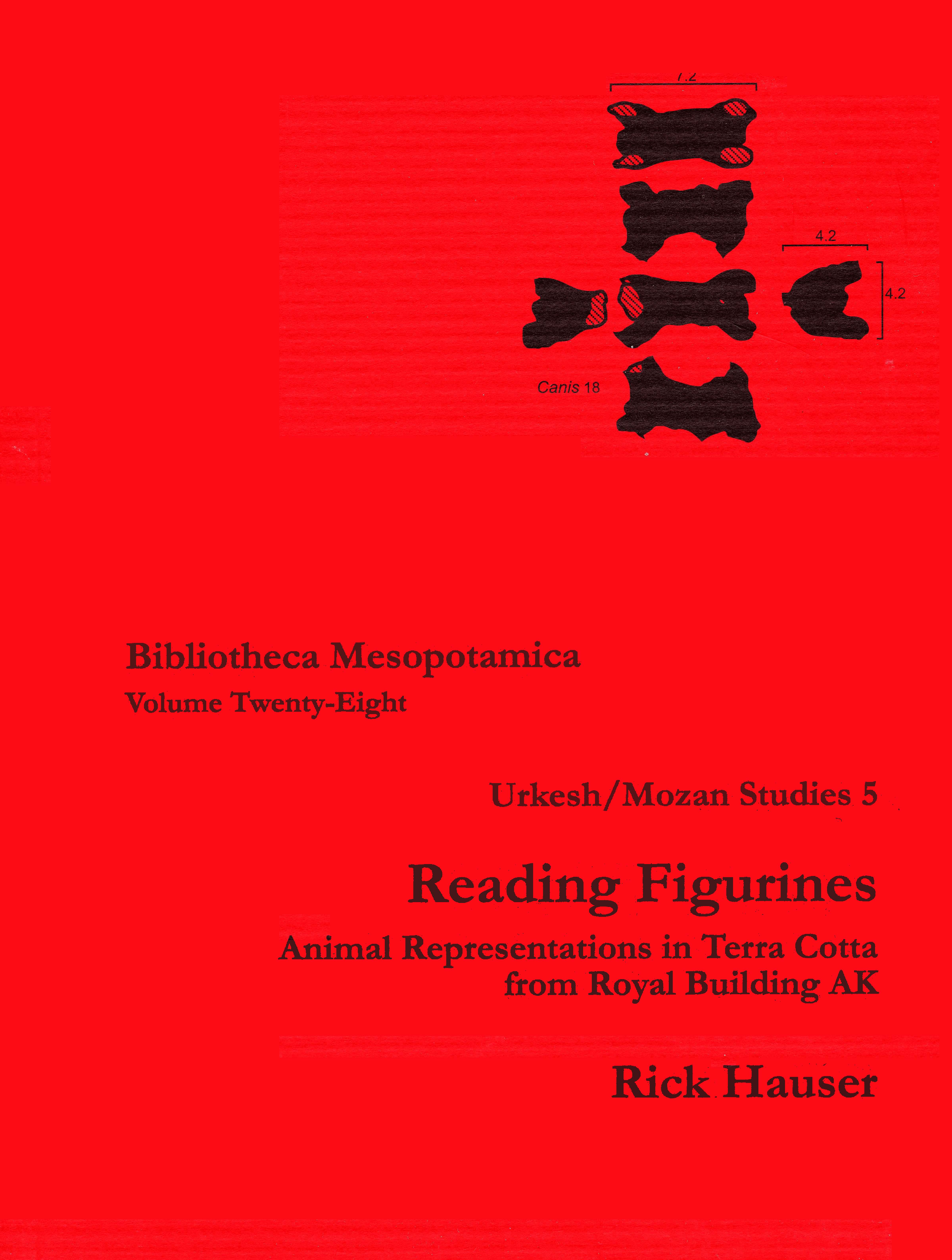
|
| UMS 6 |
Federico Buccellati Three–dimensional Volumetric Analysis in an Archaeological Context. The Palace of Tupkish at Urkesh and its Representation. Malibu: Undena Publications, 2016. TABLE OF CONTENTS Foreword Preface Acknowledgments
Appendix: BlockGen Vademecum and Program Code AP Palace Wall Catalog [Cf. also Federico Buccellati's dissertation.] |
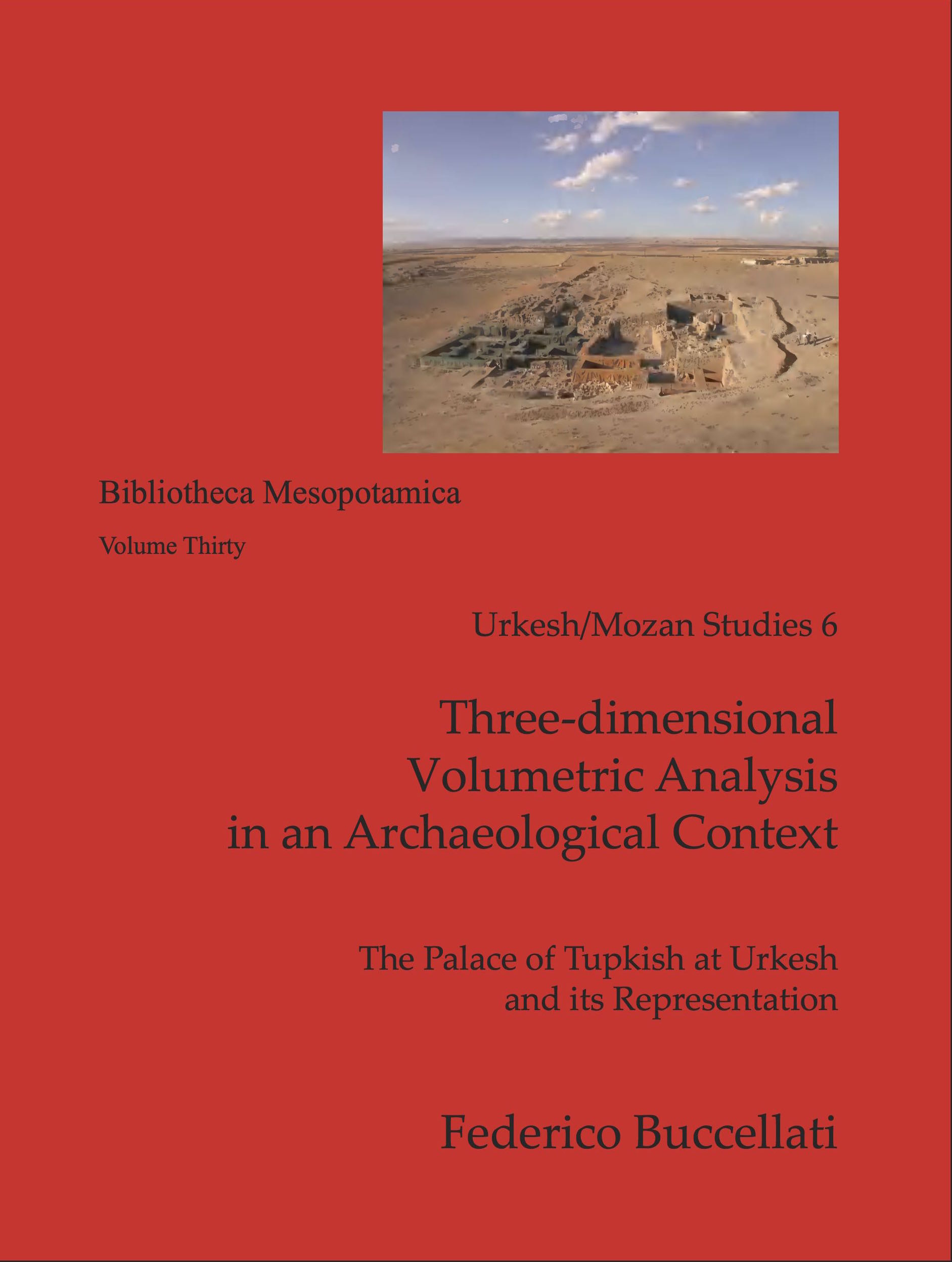
|
| UMS 7 |
Matteo Delle Donne Agricoltura, alimentazione e paleoambiente della Jazira siriana tra IV e III mill. a.C. – le evidenze da Tell Mozan. Napoli: UniOr Press, 2018. ISMEO webpage SHARE Libri webpage Prefazione Introduzione
Appendice II. I resti vegetali. Tabelle Summary Bibliografia |
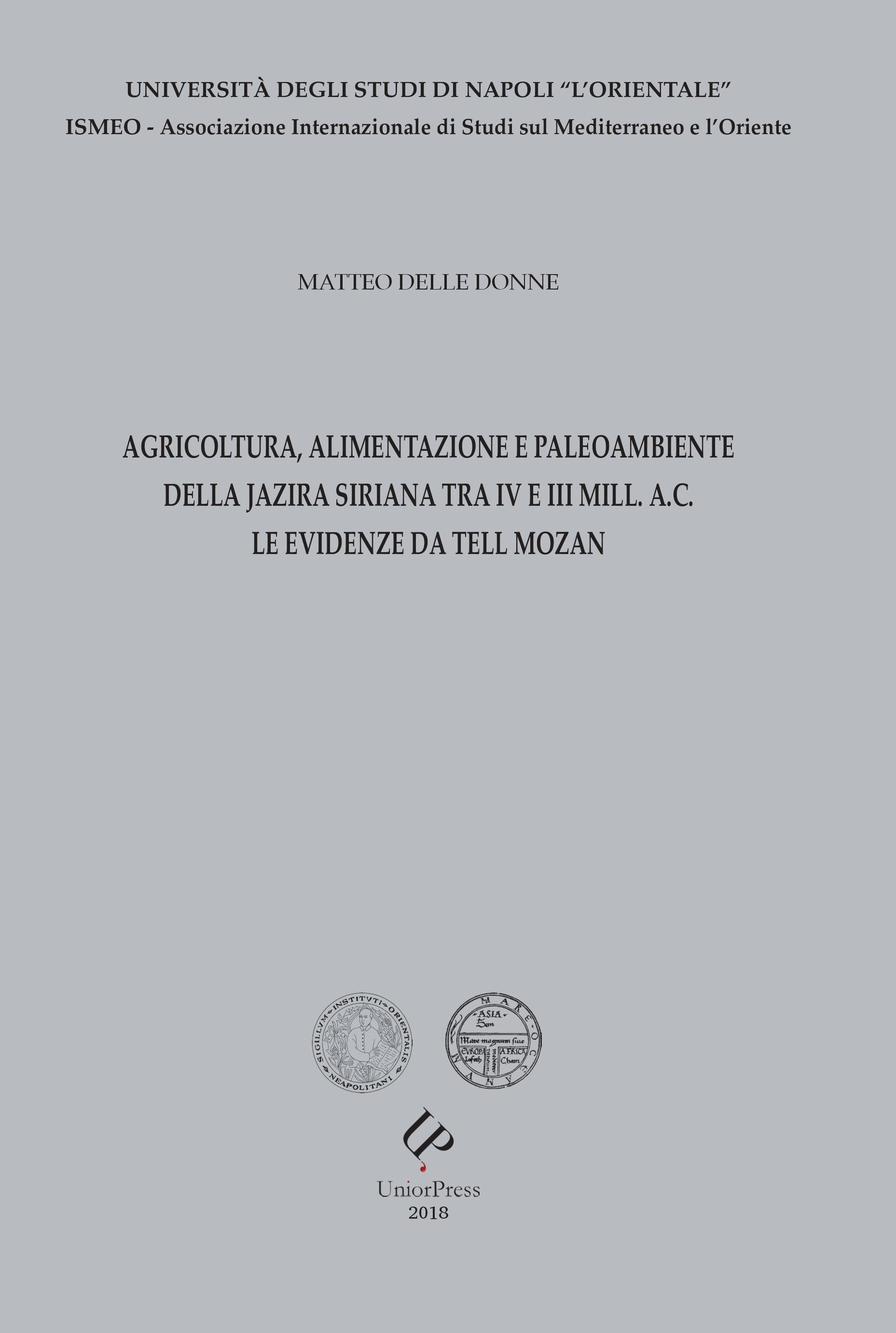
|
Other Studies
This second sections presents some other important works devoted to topics related to Tell Mozan:
|
Critique (CAR)
|
Giorgio Buccellati A Critique of Archaeological Reason. Structural, Digital, and Philosophical Aspects of the Excavated Record. Cambridge: Cambridge University Press, 2017. Publisher's page Preface 1. Introduction PART I: FUNDAMENTALS 2. Archaeology and Grammar 3. Categorization 4. The Search for Objectivity PART II: ANALYSIS 5. Stratigraphic Analysis 6. Typological Analysis 7. Integrative Analysis PART III: THE REASSEMBLED CONSTRUCT 8. The Invention of a Site 9. The Physical Record 10. The Referential Record PART IV: THE PRIVILEGED VENUE 11. Digital Thought 12. Digital text 13. The Archaeological Record PART V: THE WIDER FRAME 14. The Relevance of Structure 15. The Critical Approach 16. Hermeneutics 17. Conclusion Bibliography Index [Cf. also CAR website.] |
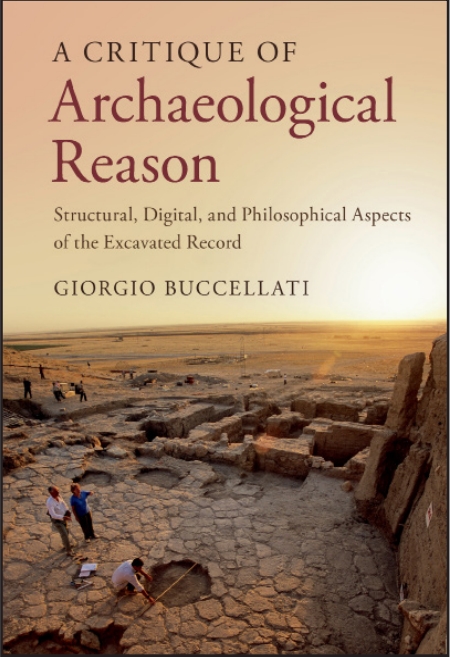
|
SANEM 3
|
Stefano Valentini and Guido Guarducci (eds) Between Syria and the Highlands. Studies in Honor of Giorgio Buccellati & Marilyn Kelly-Buccellati. Studies on the Ancient Near East and the Mediterranean 3, Roma: Arbor Sapientiae Editore, 2019. Aknowledgements Foreword (Stefano Valentini, Guidi Guarducci) Giorgio Buccellati & Marilyn Kelly-Buccellati (Biography) Giorgio Buccellati (Bibliography) Marilyn Kelly-Buccellati (Bibliography) Author Biographies
|
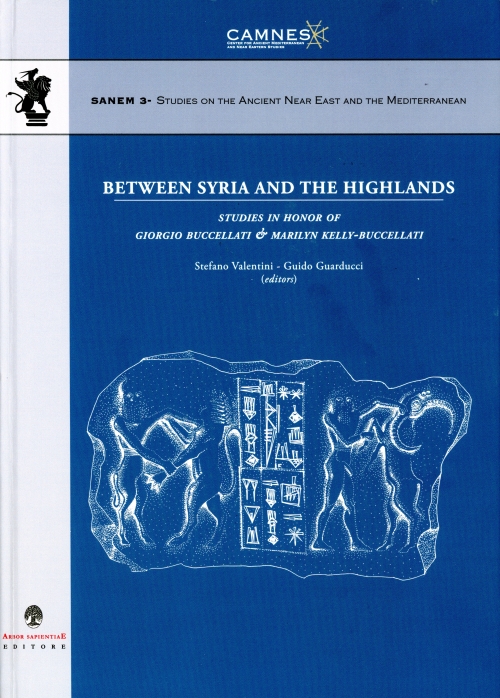
|
Guide Books and Exhibits
|
This third section displays some books with are guides to the site of Tell Mozan or catalogues of exhibits. Some guides/catalogues are monolingual (e.g. Georgia), others are plurilingual (e.g. Invitation to Mozan, which is in English, Arabic, and Kurdish); sometimes the same publication has been translated (from its original Italian version) also in English and Arabic. |
Invitation to Mozan
|
Giorgio Buccellati An Invitation to Tell Mozan, Ancient Urkesh. A multilingual guide to the site. Mozan: The Urkesh Press, 2014. TABLE OF CONTENTS Introduction In tune with the Past The High Mound The Urkesh Monumental Urban Complex Urkesh Historical Context A new ancient Syrian civilization The Hurrians The identification of Urkesh Urkesh over the three millennia/1 Urkesh over the three millennia/2 Urkesh During the Fourth Millennium B.C. A very early date for Urkesh, and why it matters The other “urban revolution” The Temple The Temple of the Lion Hurrian Gods Other Hurrian ritual practices: the altanni The Palace of Tupkish Political power: Tupkish Palace King Tupkish The Abi The abi Stratigraphic history of the abi Finds from the abi Art Urkesh art during the third millennium B.C.: Sculpture Urkeshart during the third millennium B.C.: Stone Stele Urkesh art during the second millennium B.C.: Expressionism Urkesh art during the second millennium B.C.: Faces Writing Writing in Urkesh Tablets from Urkesh Glyptic Urkesh glyptic and seals The queen as ruler The courtiers of Tar’am–Agade Queen Uqnitum The crown prince Conservation – The Site as a Book |
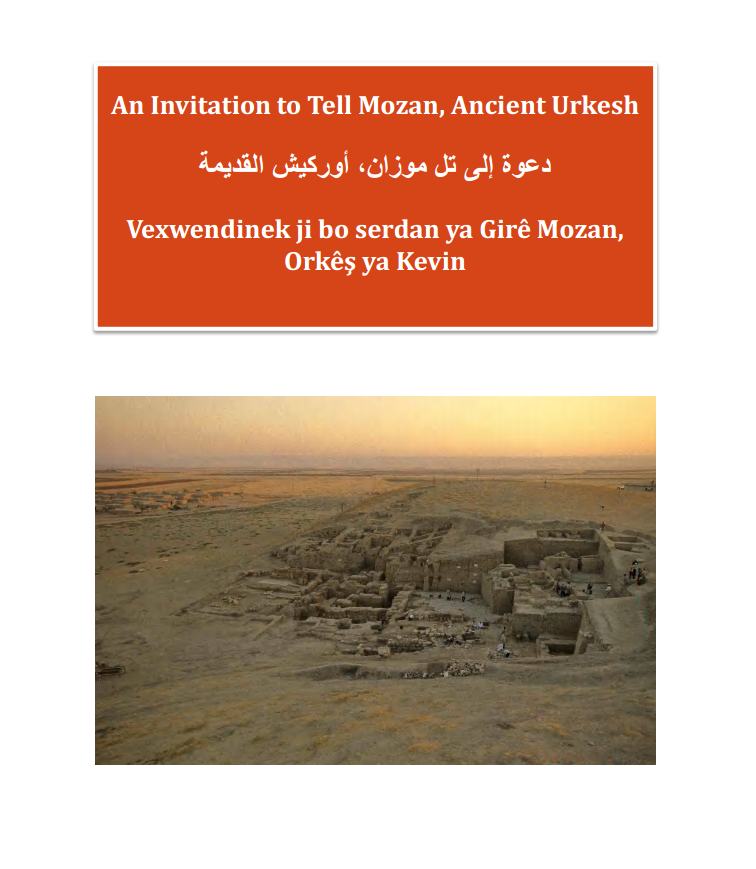
|
Dal Profondo
|
Giorgio Buccellati with Marilyn Kelly–Buccellati Dal profondo del tempo. All'origine della comunicazione e della comunità nell'antica Siria. Firenze: Società Editrice Fiorentina, 2014. Publisher's page Premessa Introduzione
Bibliografia |
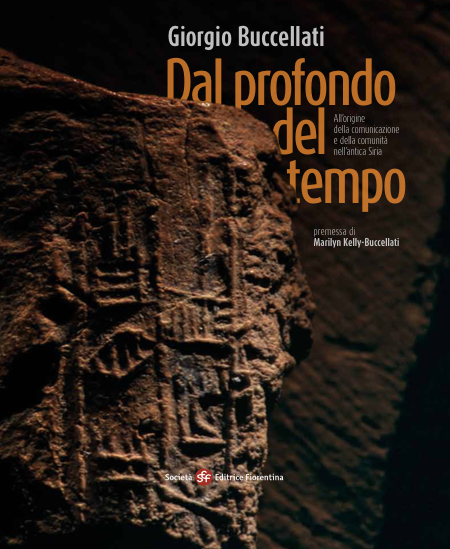
|
Dal profondo (Arabic)
|
قدمت لها ميرلين كيللي بوتشيللاتي جورجيو بوتشيللاتي Giorgio Buccellati with Marilyn Kelly–Buccellati من عمق الزمان إلى جذور التواصل والمجتمع في سورية القديمة Dal profondo del tempo. All'origine della comunicazione e della comunità nell'antica Siria. Arabic translation. Firenze: Società Editrice Fiorentina, 2014. Arabic table of contents:
من عمق الزمان
شكر
|
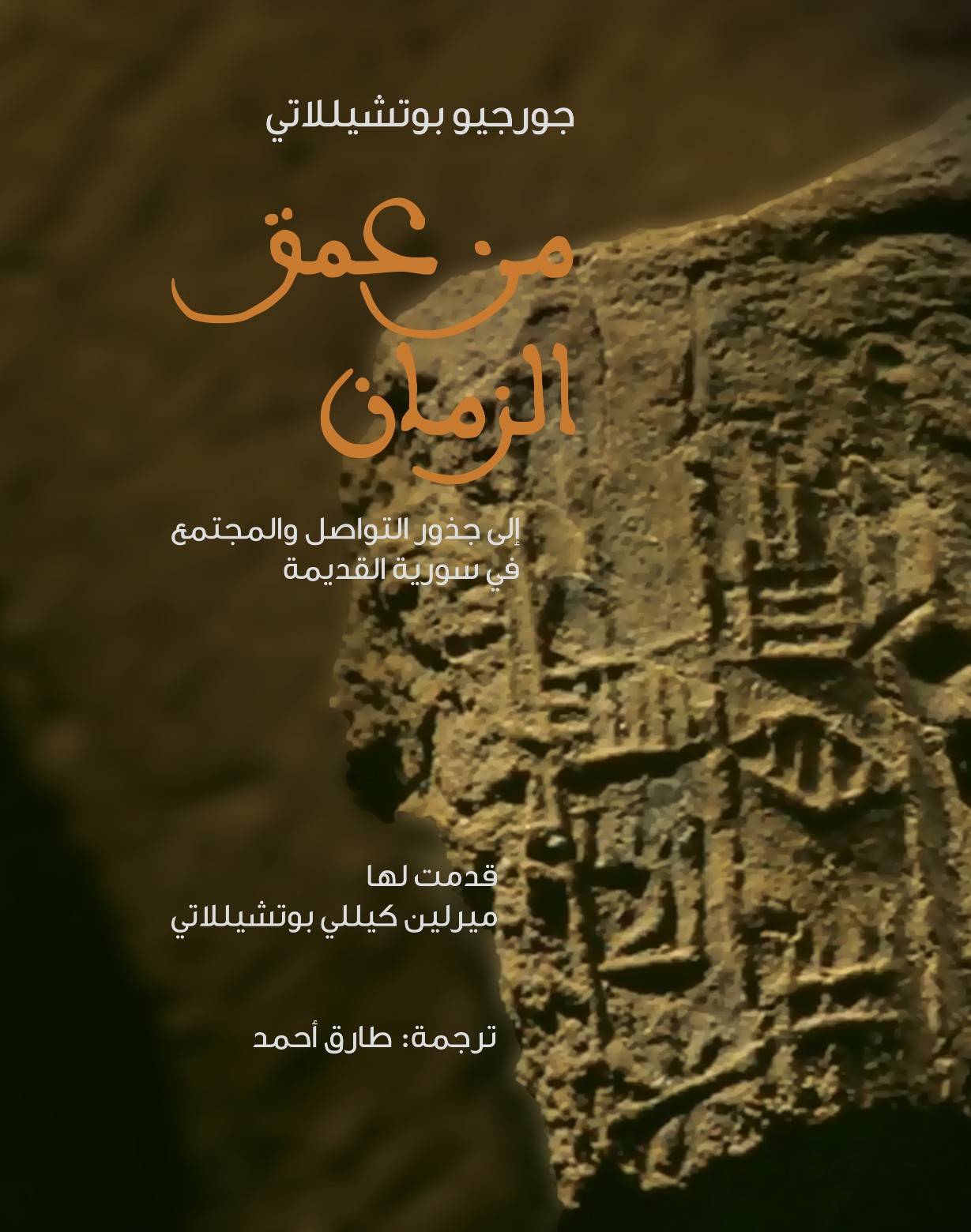
|
Georgia
|
Marilyn Kelly–Buccellati Georgia. Paese d'oro e di fede. Identità e alterità nella storia di un popolo. Firenze: Società Editrice Fiorentina, 2016. Publisher's page English abstract Premessa (Marilyn Kelly–Buccellati) Prefazione (David Lordkipanidze) Introduzione (Marilyn Kelly–Buccellati) A volo d'uccello (Marilyn Kelly–Buccellati e Giovanni Santambrogio)
Bibliografia Crediti fotografici Collaborazioni |
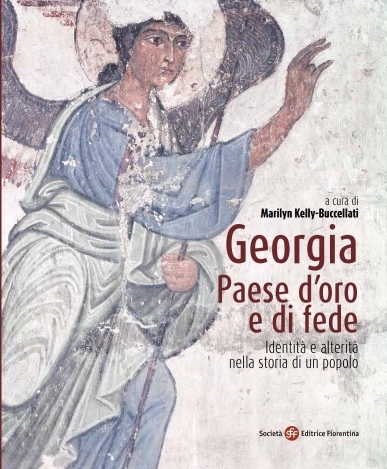
|
Young Future
|
Giorgio Buccellati and Yasmine Mahmoud Archaeology for a young future. An exhibit at the American University of Beirut. Mozan: The Urkesh Press, 2017. Archaeology Foreword Preface Provocations The dignity of the past The temple The necromantic shaft The royal palace of Tupkish A site alive The vigor of the women Of sherds and men The power of ideals Reflections Acknowledgments |
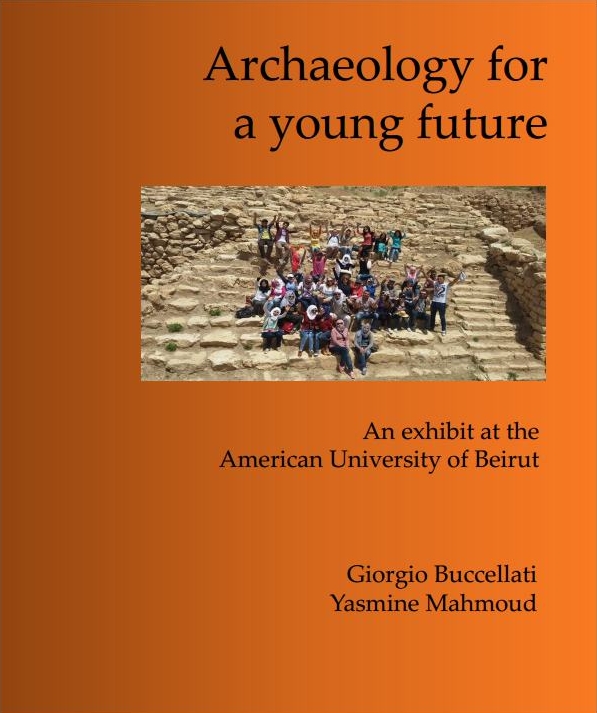
|
I millenni per l'oggi
|
Giorgio Buccellati, Stefania Ermidoro and Yasmine Mahmoud I millenni per l'oggi. L'archeologia contro la guerra: Urkesh di ieri nella Siria di oggi. Firenze: Società Editrice Fiorentina, 2018. Publisher's page Premesse Il valore dell'archeologia per una Siria unita (Mahmud Hamud) La condivisione dei sostenitori (Giuseppe Guzzetti) La promessa di un future giovane (Marilyn Kelly–Buccellati, Giorgio Buccellati) Introduzione. L'urgenza di comunicare. La tematica della mostra (Giorgio Buccellati)
Ringraziamenti Crediti fotografici |
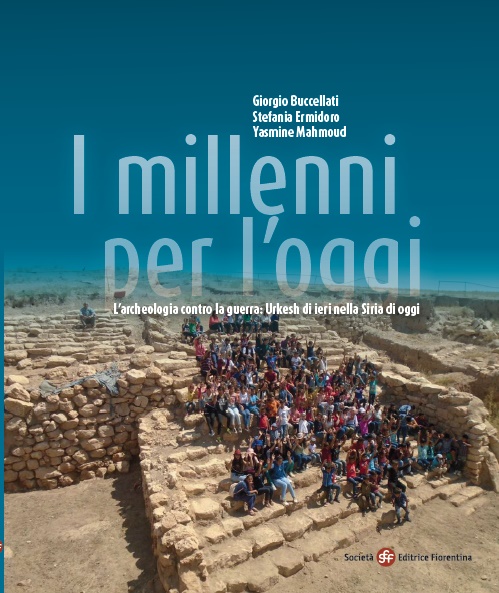
|
I millenni per l'oggi (Arabic)
|
جورجيو بوتشيالتي ستيفانيا إرميدورو ياسمين محمود Giorgio Buccellati, Stefania Ermidoro and Yasmine Mahmoud األلفية منأجل اليوم علم اآلثار يف مواجهة الحرب: أوركيش األمس يف سوريا اليوم I millenni per l'oggi. L'archeologia contro la guerra: Urkesh di ieri nella Siria di oggi. Arabic translation. Firenze: Società Editrice Fiorentina, 2018. Arabic table of contents:
الألفية من
خاتمة."... وجه المدينة:" بقلم دومينيكو كويريكو
|
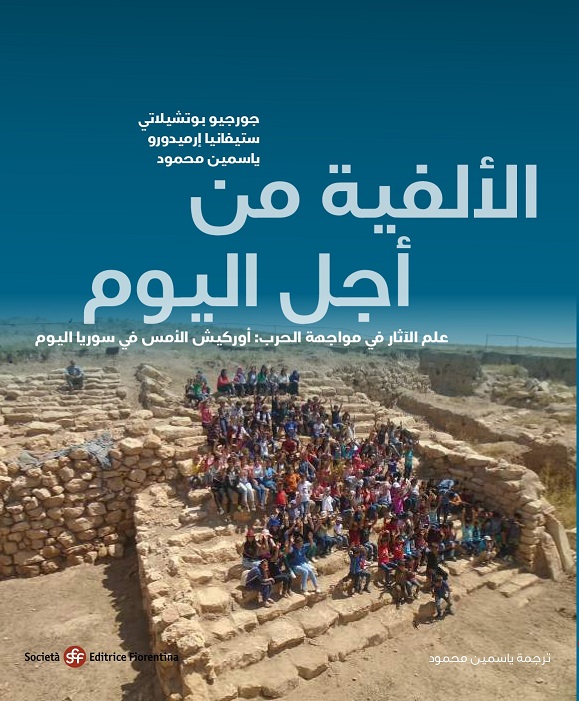
|
Millennia for Today
|
Giorgio Buccellati, Stefania Ermidoro and Yasmine Mahmoud The Millennia for Today. Archaeology agaist war: Yesterday's Urkesh in today's Syria. Firenze: Società Editrice Fiorentina; Undena Publications: Malibu, 2019. Foreword The value of archaeology for a united Syria (Mahmud Hamud) The supporters as partners (Giuseppe Guzzetti) The promise of a young future (Marilyn Kelly–Buccellati, Giorgio Buccellati) Introduction. The urgency to communicate. The theme of the exhibit (Giorgio Buccellati)
Acknowledgments Credits |
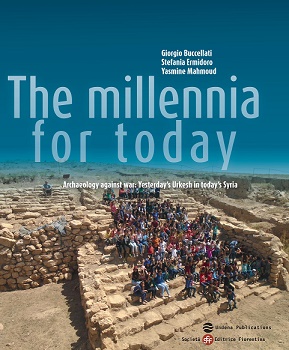
|